#King Tut's Tomb
Photo

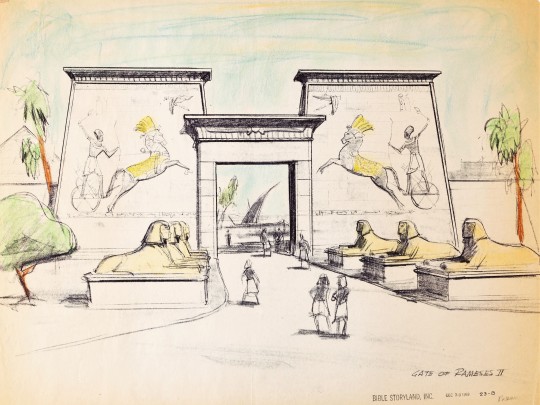




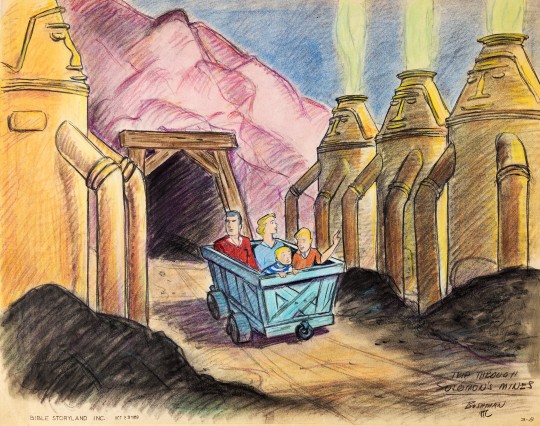
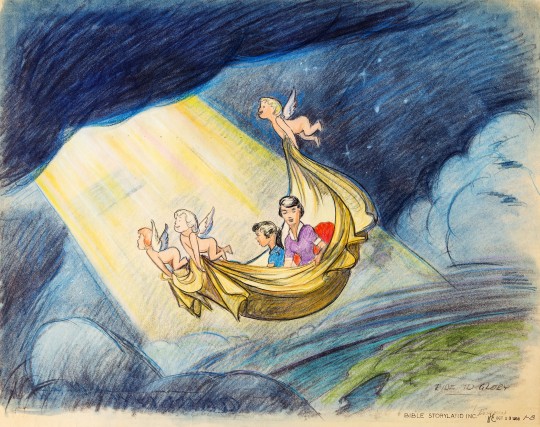

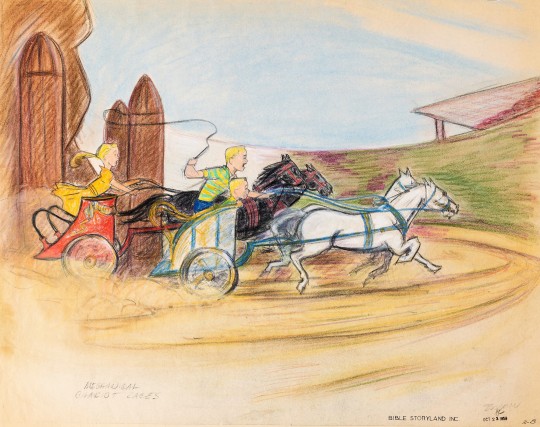
Bible Storyland amusement park concept art by Bruce Bushman (1959)
#bruce bushman#bible storyland#concept art#amusement parks#dark rides#rameses ii#valley of the kings#king tut's tomb#dead sea#ur bazaar#king solomon's mines#chariot races#nat winecoff enterprises#1950s#1959
44 notes
·
View notes
Quote
Slowly, desperately slowly it seemed to us as we watched, the remains of passage debris that encumbered the lower part of the doorway were removed, until at last we had the whole door clear before us. The decisive moment had arrived. With trembling hands I made a tiny breach in the upper left hand corner. Darkness and blank space, as far as an iron testing-rod could reach, showed that whatever lay beyond was empty, and not filled like the passage we had just cleared. Candle tests were applied as a precaution against possible foul gases, and then, widening the hole a little, I inserted the candle and peered in, Lord Carnarvon, Lady Evelyn and Callender standing anxiously beside me to hear the verdict. At first I could see nothing, the hot air escaping from the chamber causing the candle flame to flicker, but presently, as my eyes grew accustomed to the light, details of the room within emerged slowly from the mist, strange animals, statues, and gold—everywhere the glint of gold. For the moment—an eternity it must have seemed to the others standing by—I was struck dumb with amazement, and when Lord Carnarvon, unable to stand the suspense any longer, inquired anxiously, “ Can you see anything ? ” it was all I could do to get out the words, “Yes, wonderful things.” Then widening the hole a little further, so that we both could see, we inserted an electric torch.
Howard Carter, The Tomb of Tutankhamun (1923), pp. 95-96
#tutankhamun#tomb of tutankhamun#howard carter#kemet#ancient kemet#egyptology#discovery of king tut#discovery of king tut's tomb#king tut#tut#king tut's tomb
1 note
·
View note
Photo

Howard Carter was born on May 9, 1874. A British archaeologist and Egyptologist who discovered the intact tomb of the 18th Dynasty Pharaoh Tutankhamun in November 1922, the best-preserved pharaonic tomb ever found in the Valley of the Kings. The discovery, funded by Lord Carnarvon, received worldwide press coverage. With over 5,000 artifacts, it sparked a renewed public interest in ancient Egypt, for which Tutankhamun's mask, now in the Egyptian Museum, remains a popular symbol.
#howard carter#king tut#tutankhamun#archaeology#egyptology#valley of the kings#king tut's tomb#science#science birthdays#science history#on this day#on this day in science history
0 notes
Text
Little Riddler and Batman panel redraw of King Tut’s Tomb. (Not unburied universe cause my dumbass didn’t google Bruce)

#riddler#Edward Nygma#Batman#Gotham#rogues gallery#dc#dc comics#THIS IS NOT FROM UNBURIED JUST A PANEL REDRAW OF A COMIC#King tuts tomb#Batman confidential
42 notes
·
View notes
Text
King Tut’s tomb was sealed in such a hurry that they didn’t even wait for the wall paint to dry. What was behind this sudden rush to entomb the boy king?
24 notes
·
View notes
Photo
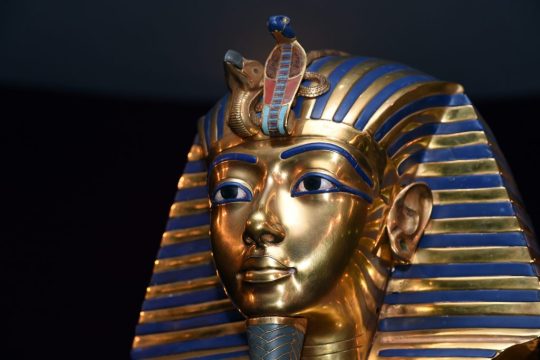
The 5 Most Opulent Artifacts Found in King Tut’s Inner Tomb
All that glitters is sometimes gold—particularly when it comes to the tomb of King Tutankhamun.
There is perhaps no other period in human history that has captured minds and imaginations quite like ancient Egypt. “Egyptomania,” or the intense interest in all thing Egypt, was first sparked by Napoleon’s Egyptian Campaign at the turn of the 19th century. Throughout the 1800s, people across the world emulated the architecture and design of Egyptian culture—for example, Victorian-era jewelry frequently incorporated scarabs, and cartouches and monuments across Europe took the form of obelisks.
The pervasive obsession with Egypt reached an apogee when on November 26, 1922, archaeologist Howard Carter and his team discovered the doorway to the tomb of Pharaoh Tutankhamun (commonly referred to as King Tut) in the Valley of the Kings on the west bank of the Nile. Though archaeological digs had been undertaken throughout the area, most tombs had succumbed to looting and grave robbing, leaving them stripped bare of their original contents. Tut’s tomb, however, had been hidden by debris and rubble, preserving it to near perfect condition.
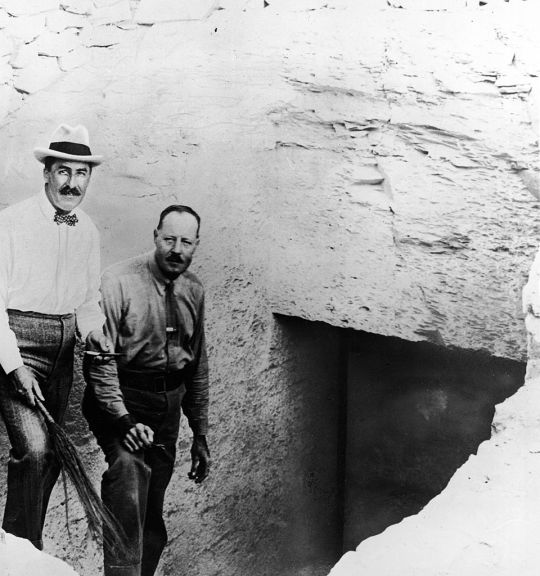
Despite discovering King Tutankhamun’s tomb in late 1922, it took several months for archaeologists to work their way through and catalogue the contents within the outer chambers. On February 16, 1923, Carter finally came face-to-face with the doorway leading to the tomb’s inner burial chamber and unsealed it. What he and his team were met with was the most well-preserved and intact pharaonic tombs ever found. Over the following eight years, the items and goods contained therein were carefully catalogued and removed, and today are held in the collection of the Egyptian Museum in Cairo.
To mark the centennial of the unsealing of the burial chamber, we’ve gathered five of the most opulent and intriguing artifacts that were found in King Tutankhamun’s tomb.
Tutankhamun’s Sarcophagus and Three Coffins:

Seeing the sarcophagus was perhaps one of the most exciting moments for the archaeologists at the time, as it indicated early on that the contents were preserved and intact. Crafted of quartzite and red granite, and displaying the images of Isis, Nephthys, Neith, and Serqet, the sarcophagus housed three nesting coffins which held Tutankhamun’s mummified body. The outer two coffins are made of fully gilded wood and inlaid with glass and semiprecious stones, such as turquoise and lapis lazuli. The innermost coffin, however, is made almost entirely out of 110.4 kilos of solid gold, similarly adorned with inlaid stones, and incised with inscriptions and in the shape of Osiris holding scepter and flail.
The Death Mask of Tutankhamun

Found within the innermost coffin upon the mummified body, King Tut’s death mask has become a world-recognized icon of ancient Egypt and the pharaonic era. Composed of 10.23 kilos of solid gold, it depicts Tutankhamun wearing the traditional stripped pharaonic headdress replete with representations of the goddesses Nekhbet and Wadjet above his brow. The mask’s back and shoulders are inscribed in Egyptian hieroglyphs with a protective spell copied from the Book of the Dead, offering protection as the pharaoh moved through the underworld.
Canopic Shrine

In the process of mummification, many of the person’s organs are removed and placed in what are called canopic jars. These containers frequently included lids shaped after the heads of the Sons of Horus, protective deities. Like many other ancient Egyptian tombs, King Tut’s included an alabaster canopic chest containing the four separate jars. However, in the pharaoh’s tomb, these were housed in a canopic shrine. Standing at six-and-a-half feet tall and enrobed in gold, the shrine includes the figure of the goddess Nepthys who stands guard over the royal contents.
Golden Sandals
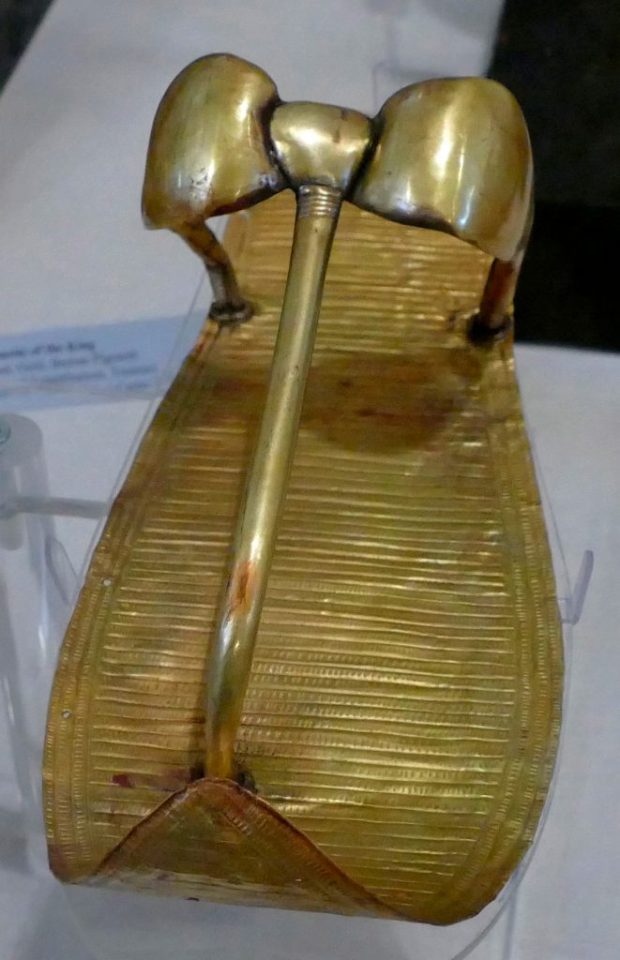
A large swathe of the items found in King Tutankhamun’s tomb represented personal necessities, such as clothing, toiletries like perfume, and food stuffs. Included among these items were a pair of gold sandals. These golden shoes have been found in numerous other ancient tombs, and it is believed that they were made specifically for funerary and burial practices. The soles of the shoes depict the nine traditional enemies of Egypt, including the Nubians and Libyans, symbolizing that as god-king they were literally beneath his feet.
Golden Chariot
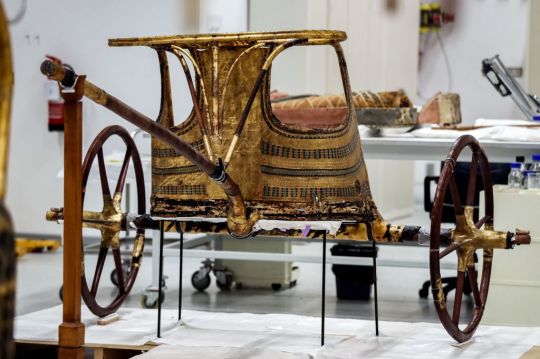
King Tutankhamun’s tomb contained a total of six golden chariots—though, unfortunately, all were in various states of disrepair as they were either mishandled or damaged by looters. After restoration, they were identified as typical D-cab chariots that were meant to be drawn by two horses. The image of a pharaoh driving a chariot was a common symbol of royal power and wealth, and in ancient times, pharaohs were often presented at public events in opulent chariots to highlight their status.
By Annikka Olsen.
#The 5 Most Opulent Artifacts Found in King Tut’s Inner Tomb#King Tutankhamun#Howard Carter#ancient tombs#ancient graves#ancient artifacts#archeology#archeolgst#valley of the kings#gold#treasure#history#history news#ancient history#ancient culture#ancient civilizations#ancient egypt#egyptian history#egyptian pharaoh#egyptian art
50 notes
·
View notes
Text

Bad movie I have The Curse of King Tut's Tomb
#The Curse of King Tut's Tomb#Casper Van Dien#Jonathan Hyde#Leonor Varela#Steven Waddington#Niko Nicotera#Tat Whalley#Brendan Patricks#Patrick Toomey#Malcolm McDowell#Simon Callow#Tom Alter#Rajesh Balwani#Robin Das#Parvin Dabas#Nikita Anand#Shakeel Khan#Vikrant Chaurasia#Vir Das#Suvarchala Narayanan#Tony Mirrcandani#Theron D'Souza#David Schofield#Rajesh Kumar#Ulhas Tayad#Harsha Prasad#Ram Gopal Bajaj#Anupam Shyam#Mehul Nisar#Ajit Kelkar
15 notes
·
View notes
Text

Studied the original photo of the finding of king Tuts tomb. The photo looks so inspiring! Finding something from a world thousands of years ago is only that one can dream of...
#king tut#tutankamon#king#history#art#digital art#digital painting#sarcophagus#concept art#game art#hatshepsut#tomb#gold#treasure#national geographic#ng#ancient egypt#egypt#procreate#illustration#museum#archeology
35 notes
·
View notes
Text




Buried in his jammies 🎶
#king tut#tutankhamun#tomb#mummy#born in arizona moved to babylonia#cute they had the blanket up to his chin so you cant see where his head snapped off when they tried to remove him from his coffin#egypt#vacation#personal#iron maiden#powerslave#gpoy#selfie#me
7 notes
·
View notes
Photo
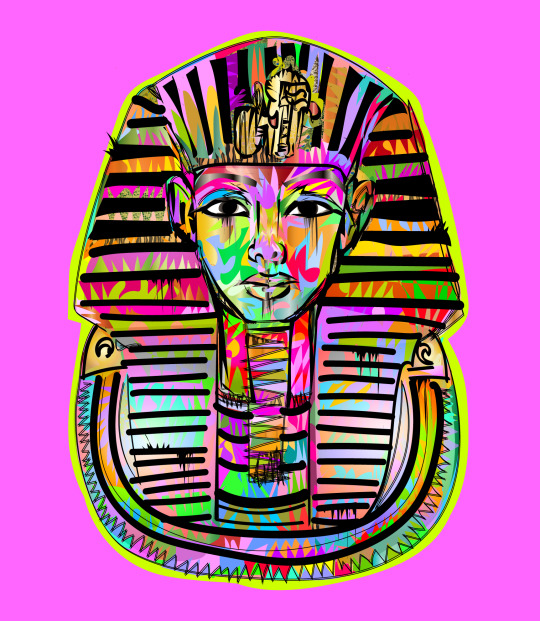
KING TUT TOMB
#king tut#tomb#pyramid#gold#book of the dead#energy#electricty#moon#toth#osiris#ra#eye of horus#hours#chronos#time#technodorme1#ancient egypt#history#knowledge
29 notes
·
View notes
Text






Truth or Scare | The Curse of Tutankhamun
“An Egyptian pharaoh entombed with a priceless fortune some 3000 years ago. 1500 years before the birth of Christ, kings of Egypt known as pharaohs were buried in the valley of the kings. A land riddled with age ol mysteries that continue to fascinate us to this day.”
#truth or scare#tutankhamun#king tut#mummies#Egypt#tombs#ancient egypt#spooky#horroredit#michelle trachtenberg#paranormal#Halloween#tv show
47 notes
·
View notes
Text
Without being flippant or ignoring the thread of colonialism that very well may have fed into his actions, to me the most impactful thing here isn't that Carter could have been unscrupulous, and that items associated with him may not have had proper provenance; it's the implication that Tutankhamun's tomb could have actually been a wholly intact one, never raided before it was opened by Carter and Carnarvon.
Some Egyptologists have challenged Carter’s claim that the tomb’s treasures had been looted in antique times. In 1947, in an obscure scientific journal in Cairo, Alfred Lucas, one of Carter’s employees, reported that Carter secretly broke open the door to the burial chamber himself, before appearing to reseal it and cover the opening.
Brier said: “They were suspected of having broken into the tomb before its official opening, taking out artefacts, including jewellery, sold after their respective deaths. It’s been known that Carter somehow had items, and people have suspected that he might have helped himself, but these letters are dead proof.
“He certainly never admitted it. We don’t have any official denial. But he was locked out of the tomb for a while by the Egyptian government. There was a lot of bad feeling, and they thought he was stealing things.”
In his book, he writes that the Egyptians were unable to prove their suspicions and were convinced, for example, that Carter had been planning to steal a wooden head of Tutankhamun found in his possession: “The Egyptian authorities had entered and inspected Tomb No. 4, which Carter and the team had used for storage of antiquities, and discovered a beautiful lifesize wooden head of Tutankhamun as a youth.
“It had been packed in a Fortnum & Mason crate but it had never been mentioned in Carter’s records of the finds, nor in the volume describing the contents of the antechamber…. Carter argued that it had simply been discovered in the rubble in the descending passage.”
(Although that wouldn't necessarily explain the expensive elements of larger artifacts that were broken off or oils and unguents that are talked about as missing. They would have had commercial value as objects in ancient times but nowhere near as much significance in the 20th century.)
#tutankhamun#tutankhamen#king tut#tomb of tutankhamun#howard carter#early archeology#ancient egypt#egyptology#bob brier
59 notes
·
View notes
Text
Nikola: I'm in.
Will: Can we trust you?
Nikola: Not usually. But I'd rather not have the world taken over by angsty trust fund vampires.
#nikola tesla#will zimmerman#incorrect quotes#incorrect sanctuary quotes#source: curse of king tut's tomb#i speak#mine#had to change this one a little bit but#yeah
15 notes
·
View notes
Text
Seeing a Large Cat

I have begun reading #9 in the Amelia Peabody mysteries, "Seeing A Large Cat". In the early part of the book, they mention Theodore Davis. Emerson refers to him as a "wealthy dilettante". While Davis was not an actual archaeologist or Egyptologist, he was important in the world of Egyptian archaeology. Davis discovered artefacts relating to Tut. He believed, though, that there were no more relics to be found, once he found the items. Here is the whole story:
#Theodore Davis#King Tut#tutankhamun#artefacts#egypt#ancient egyptian artifacts#egyptian history#egyptology#Valley of the Kings#Howard Carter#Howard Carter-Theodore Davis Partnership#history#archaeology#ancient history#Tuthmosis IV’s tomb#burial tombs#readingamelia#Amelia Peabody mysteries#Elizabeth Peters#Barbara Mertz
8 notes
·
View notes
Photo

This Monday I've read The Hound of the Baskervilles. It was not scary at all, just a mindless quick novel of Sherlock Holmes which in 1982, the BBC got Tom Baker to play.
Thus, after reading it, I gathered five of his roles doing something a bit random (randomness is my nature) The egyptian doctor and Holmes think Koura is sick and give him an exam, while the Doctor and Hasan simply stand here and watch.
Baker is a really good Doctor, but as you can tell...Pertwee takes the first place on my Doctor Who incarnations podium.
By the way, for anyone who wants to watch The Hound of the Baskervilles by Tom Baker...is in the Internet Archive (Youtube's got a few parts missing due to BBC's copyright)
Hasan's here as well...The Curse of King Tut's Tomb from 1980 is probably a lost flick (pretty sure it's a TV movie), and he plays this background character so well...
Hope you like it!
Artwork (c) @CreativeCuquiLu
Doctor Who, The Millionairess and The Hound of the Baskervilles (c) BBC
The Golden Voyage of Sinbad (c) Columbia Pictures
The Curse of King Tut's Tomb (c) Columbia Pictures Television
WATCH IT - https://www.youtube.com/watch?v=gB8k_h3hNn0&t=1s
Also, here’s a bonus link to Hasan scenes cuz SOMEHOW, THIS EXACT T. BAKER ROLE TURNS ME ON 😫😫
#speedpaint#tribute#tom baker#pixelart#doctor who#the doctor#fourth doctor#the millionairess#egyptian#fez#fezzes are cool#the golden voyage of sinbad#koura#sherlock holmes#the hound of the baskervilles#the curse of king tut's tomb#hasan#background character#tv movie#lost flick#lost media#(i guess?)#random#exam#roles
4 notes
·
View notes
Text
King Tutankhamun’s tomb isn’t like the tombs of other Egyptian pharaohs. There are lots of theories as to why, including the idea it was originally built for a woman.
14 notes
·
View notes